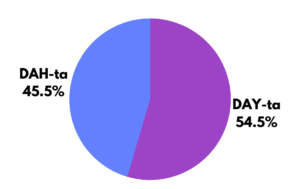by Aimee Brown

Let’s get straight to the (data) point: if you aren’t using your data (and second and third party data) to inform your marketing efforts, you are probably missing out on opportunities and efficiencies.
Without analyzing and understanding your sales and marketing data, you can’t make fact-based decisions for your marketing strategy. Which means you’ll be losing lots of time (and money) just throwing things at the wall and seeing what sticks.
What is data?
First, what do we mean when we say “data”? Sales numbers? Stock prices? A Star Trek character?
For the purposes of this blog, we’re talking marketing insights. Things like:
- Audience persona insights
- Customer demographics: age, gender, household income, city, zip code, lifestyle
- Customer feedback and motivations
- Media consumption habits and preferences: Time spent with different media, usage of specific stations, websites, platforms
- Media measurement
- Impressions, reach, frequency
- Web analytics
- Social and digital media engagement
- Sales and Marketing
- Year-over-year marketing spend
- Year-over-year business performance
- Delivery on KPIs (Key Performance Indicators): Brand awareness, engagement, conversions
And the list can truly go on and on.
Whose party is it, anyway?
Some quick definition before we go further because these three can get a little confusing. What’s the difference between first, second, and third-party data?
- First Party: Already existing customers / information you have collected about your audience from a CRM system, intake system, Google Analytics, subscribers
- Second Party: Someone else’s first party data
- Third Party: Data that is collected, aggregated, and shared for broad usage in the form of surveys, interviews, and other research methods
What does data tell us?
In a nutshell? Everything. For example, if you are trying to figure out what audience is consistently finding your website and buying your products or services, you can check out the demographic data in Google Analytics. This will give you gender identity, age, location, and even things like their interests.
And once you have this information, you can then target your advertising better, reach more of the right audience, and convert more sales.
Another example is looking at your year-over-year ad spend. Did you run ads every month in 2019, but only saw most of your ROI happening in spring and fall? How about 2018? Same thing? You now have the information you need to justify reallocating your ad spend to the months that truly produce results for your company instead of wasting them for half of the year.
Telling your brand’s story
Think of it this way: Your product or service is something you know your target audience doesn’t just want, but needs. How do you make sure your story gets out there to the right people at the right time and in the right format?
The spray and pray marketing method may reach some of those people, most not at the right time, and possibly not in a format they care about.
Data-driven marketing, however, gives you cold, hard facts to guide you. By looking at Google Analytics, social media engagement, and customer feedback, you know that your target audience is:
- Women
- Ages 28-36
- Upper-middle class
- 70% of this target spends a ton of time on Instagram
- A cord-cutter
With this information in mind, are you going to waste your marketing budget on running TV spots during the 11:00pm local news? Of course not.
But an Instagram ad targeted exactly to this demographic? Bingo. Right people, right time, right format.
So, who needs marketing data?
If you’re selling any service or product, you do. Frequently looking at and analyzing your data and adjusting course for your marketing campaigns is absolutely vital to having a thriving business.
Not only does it tell you exactly who your audience is, where they are, and what they respond to, but it also cuts down on needless spending. There’s no need to run a bunch of ads on TV, radio, billboards, social, and digital in hopes that maybe someone sees it and buys what you’re selling when you can specifically pinpoint and target the people who already want it. (And those who don’t know they do yet!)
And I get it. Doing a deep dive into data isn’t everyone’s cup of fair trade small batch coffee. At HM, we’ve got a team of people who live for this stuff and want nothing more than to help you make sense of it all. If you’re ready to get started with data-driven marketing and don’t know where to start, reach out to us today.
Some bonus data on "data"
Here’s how our (virtual) office pronounces the word “data.” How about you?







![Supplier-Diverse-logo[80] Supplier-Diverse-logo[80]](https://hoffmannmurtaugh.com/wp-content/uploads/elementor/thumbs/Supplier-Diverse-logo80-q1aarjz0bfmhzi7ttv7rocd5wxiwta6bizbjwmiync.png)